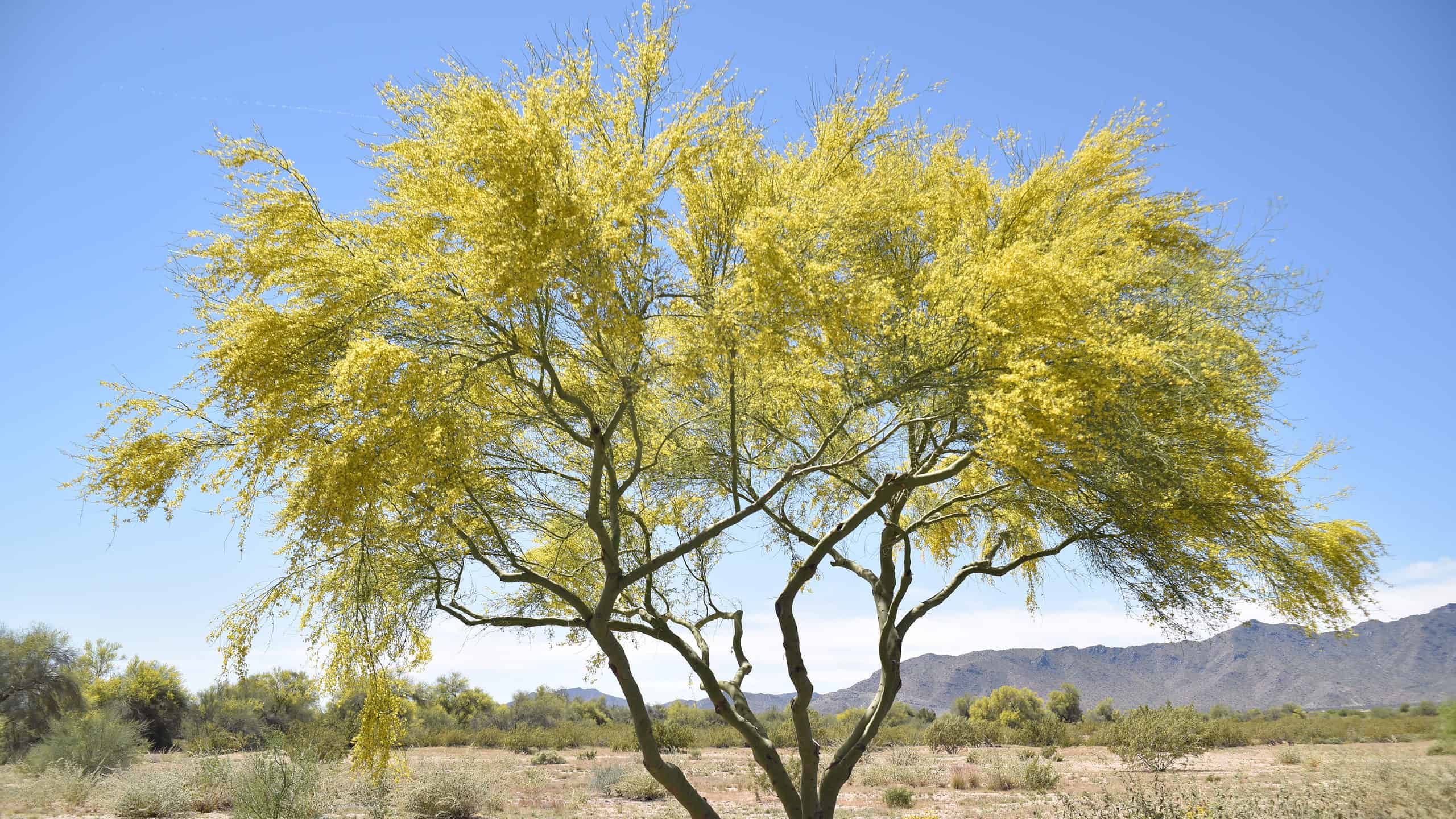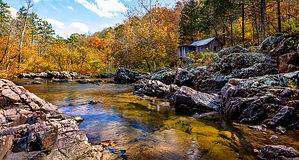While Arizona is best known for its desert climate, that is not the only climate zone to be found in the state. The varying climates produce a diversity of magnificent trees that are endemic to the state. Here are ten incredible trees native to Arizona.
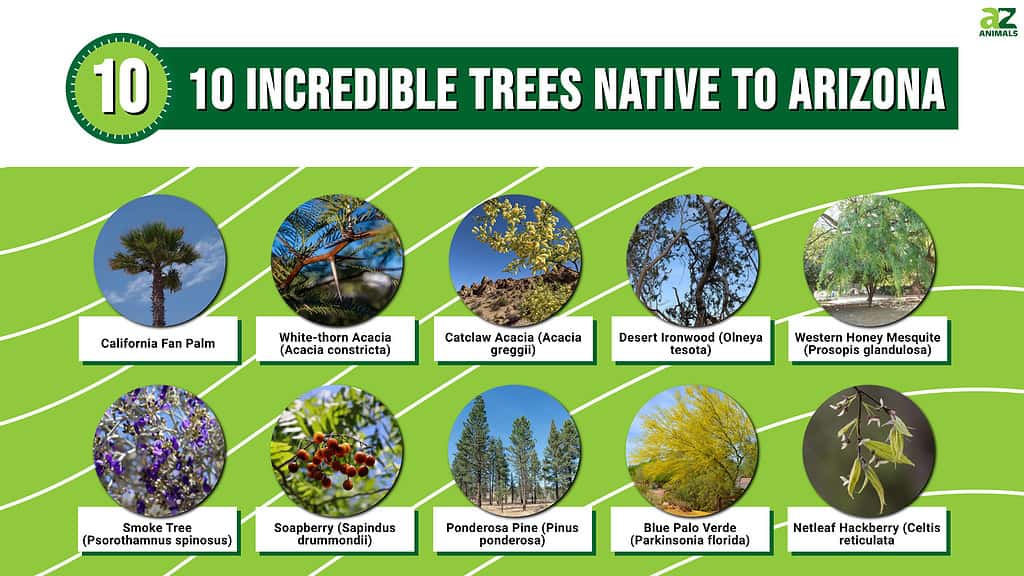
1. California Fan Palm
You don’t have to look far for palm trees in Arizona, but none of them are actually native to the state except for the California fan palm (also known as the desert palm).
These palms grow naturally between Yuma and Quartzite in the Kofa National Wildlife Refuge. The area is aptly known as “Palm Canyon.”
The California fan palm can grow up to 60 feet high, with a trunk girth of 2-3 feet around. The fan palm has numerous evergreen leaves, and perhaps the most interesting fact about this tree is what happens when the leaves die.
As the tree matures, old, dead leaves hang down against the trunk. The leaves create a shelter for insects, birds, and rodents. Due to the appearance of the dead leaves wrapped around the trunk, the tree is sometimes referred to as the petticoat palm.

As the California fan palm matures, the leaves that die hang down against the trunk.
©Jack N. Mohr/Shutterstock.com
2. White-thorn Acacia (Acacia constricta)
Desert trees in Arizona are numerous and include the white-thorn acacia.
This small tree can thrive in the nutrient-poor soil of a desert environment. It grows slowly but can eventually reach heights of 20 feet.
Young branches on the tree are protected with white thorns measuring up to an inch long. The tree is obviously named after these white thorns. “Acacia” also alludes to the thorny branches, as the word means “hard, sharp point.”
Puffy yellow flowers appear in late spring and again in late summer.

The branches on the white-thorn acacia tree are protected with white thorns measuring up to an inch long.
©Charles T. Peden/Shutterstock.com
3. Catclaw Acacia (Acacia greggii)
The catclaw acacia’s gnarled appearance reflects the harsh climate in which it lives. It can reach heights of 25 feet with a sweeping canopy of leaves. This deciduous tree loses its leaves in the winter and sprouts yellowish-cream-colored flowers in the spring. Birds and other animals favor the tree, and is a good source of natural honey.
The tree’s name refers to the curved sharp thorns on the stems and branches of this tree, similar to the claws of a cat.
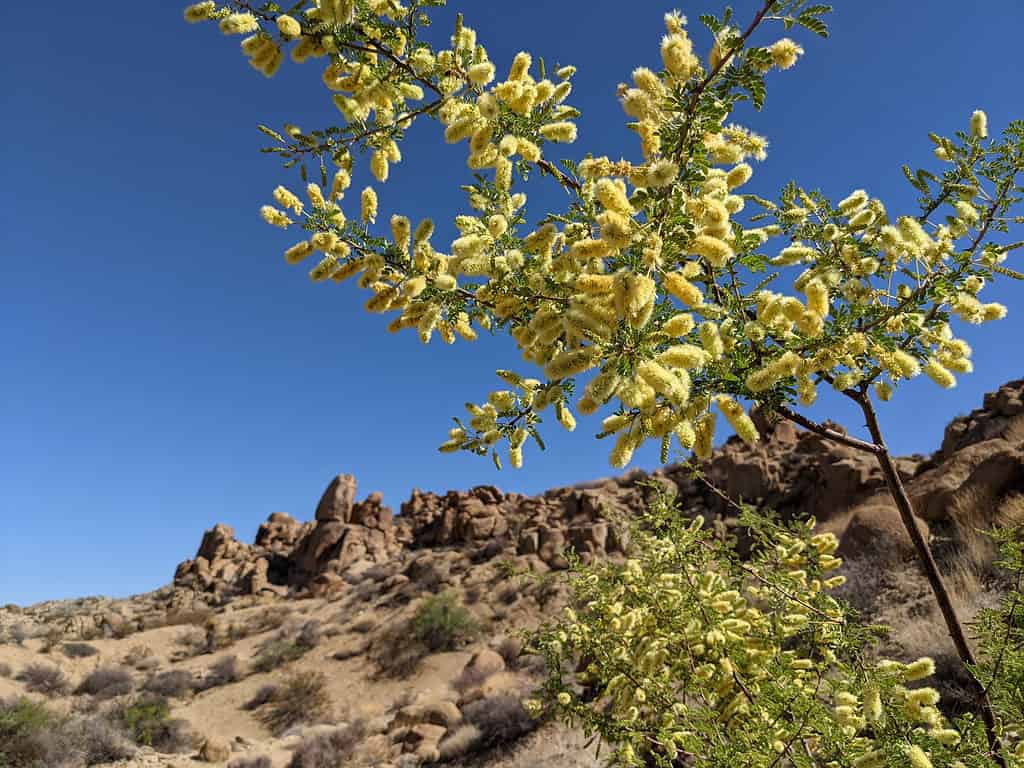
The catclaw acacia sprouts yellowish-cream-colored flowers in the spring.
©Noah Sauve/Shutterstock.com
4. Desert Ironwood (Olneya tesota)
When fully mature, this desert tree can stand as long as it is tall, measuring up to 30 feet in both directions. It has a unique domed leaf canopy that can stretch all the way to the ground.
This tree is extremely long-lived, with some living an estimated 500 years. When this tree puts down roots, it really puts down roots!
The desert ironwood provides a habitat for many different types of animals, and the seed pods are an important food source for native wildlife.
This tree can drop its leaves multiple times a year but will re-leaf quickly as weather conditions become favorable. Delightful clusters of lavender or light pink flowers appear in the spring.
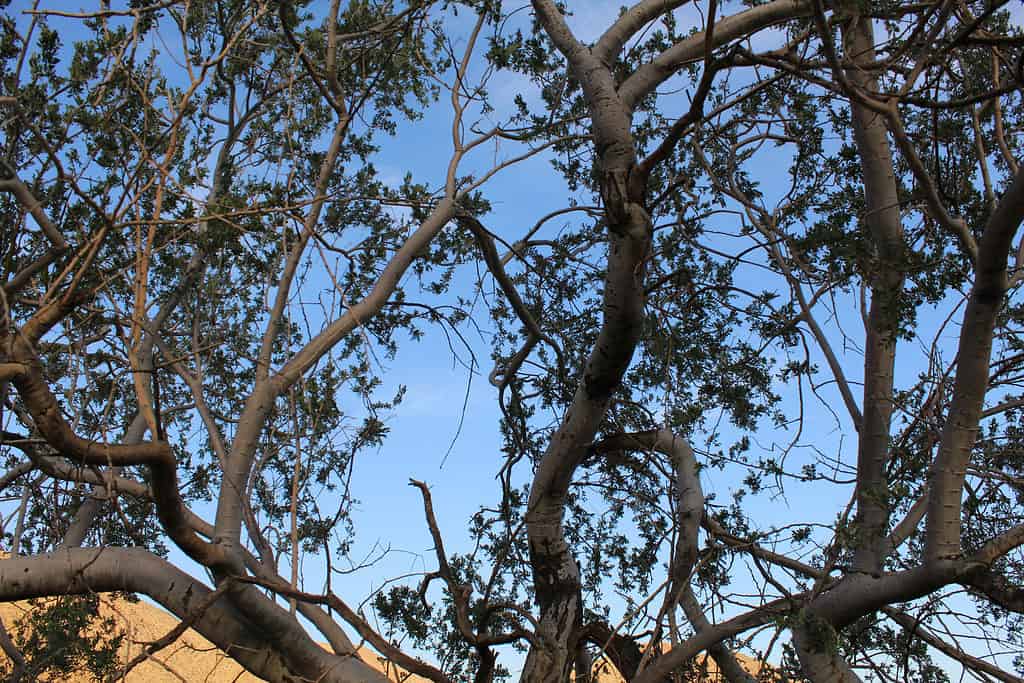
When fully grown, the Desert Ironwood can stand up to 30 feet tall.
©Jared Quentin/Shutterstock.com
5. Western Honey Mesquite (Prosopis glandulosa)
A beautiful and important tree in the Arizona ecosystem, the western honey mesquite is a favorite of human and animal residents alike.
This tree can grow upwards of 30 feet tall with “mesquite green” leaves. Being a deciduous tree, the leaves fall in the autumn and return in the spring.
The western honey mesquite brings bountiful color in the spring when it produces spikes of beautiful yellow flowers. And in the summer, seed pods of red or purple are quite pronounced.
The tree is a food source for animals such as javelinas. Human residents can mill the seed pods into sweet and nutritious flour useful in all kinds of different culinary applications.

The western honey mesquite features “mesquite green” leaves.
©Vipul1989/Shutterstock.com
6. Smoke Tree (Psorothamnus spinosus)
At first glance, this unassuming little tree may not seem to belong on a list of “incredible trees.” But for a short window in the summer, it transforms the desert landscape.
Standing around 20 feet tall, the tree is generally leafless. With ample water, tiny leaves occasionally do appear. They are not necessary to the life of the tree, though, as it photosynthesizes through its branches rather than its leaves.
The tree is named for its smoky-gray color. But for about one week in early summer, that grayish color takes a backseat to the vibrant purple flowers that appear. These flowers add an exquisite, albeit short-lived, indigo panorama to the desert environment.

Beautiful purple flowers appear on the smoke tree for about one week in early summer.
©Jared Quentin/Shutterstock.com
7. Soapberry (Sapindus drummondii)
This native Arizonan tree is a bit deceiving. It perpetually provides fruit that appears similar to small oranges, but the fruit is actually quite toxic. The fruit contains an alkaloid that makes it highly poisonous to humans.
While you definitely don’t want to eat from this tree, it does add beauty to the landscape. Topping out at around 30 feet tall, the tree features deciduous leaves that change to gorgeous hues of yellow and gold before falling to the ground for the winter. Clusters of white flowers appear in spring and early summer.
The tree’s peculiar name belies one of its lesser-known uses. While the fruit is poisonous, as previously noted, the seeds can be soaked in water and then mashed to produce a liquid that has been used in soaps.
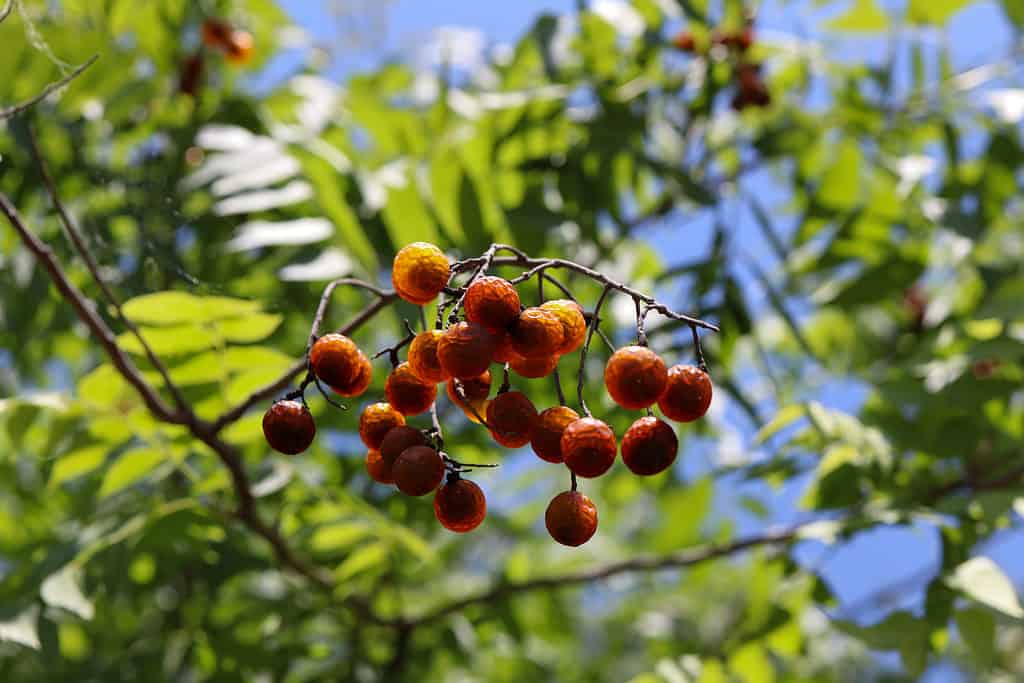
The small orange fruit of the soapberry is toxic to humans.
©John_P_Anderson/Shutterstock.com
8. Ponderosa Pine (Pinus ponderosa)
With alternate names such as the bull pine, blackjack pine, and western yellow pine, the ponderosa pine is the most widespread pine species in North America. It is the official tree of Spokane, Washington, and the state of Montana. Its large native range includes the higher elevations of Arizona.
This large conifer can reach towering heights of well over 200 feet. The bark of the tree appears in plates with black crevices in-between (hence the less common name, blackjack pine).
Its signature pine cones proliferate the tree and usually the ground underneath. The cones have a purplish tint while on the tree but turn the more recognized brown color when they fall to the ground and dry out.
The timber from the ponderosa pine is one of the most commonly used species among the western softwoods. Its versatility makes it a premier wood for many different types of decorative and utilitarian applications.

The ponderosa pine can grow to heights of over 200 feet.
©Dominic Gentilcore PhD/Shutterstock.com
9. Blue Palo Verde (Parkinsonia florida)
The blue palo verde was recognized as the state tree of Arizona in 1954.
This tree is found in the Sonoran Desert of central and southwestern Arizona, stretching west into southeastern California and south into Mexico.
“Palo verde” is Spanish for “green stick. The blue palo verde tree is so named for its bluish-green bark.
The tree is drought-deciduous, meaning it sheds its leaves for much of the year. It will leaf out after rainfall, but the tree thrives with or without leaves as it photosynthesizes through its branches.
The tree puts on a show in mid-spring when bright yellow flowers bloom and cover the tree, attracting pollinators of all kinds. The flowers are followed by seed pods which serve as a food source for birds and other small animals.
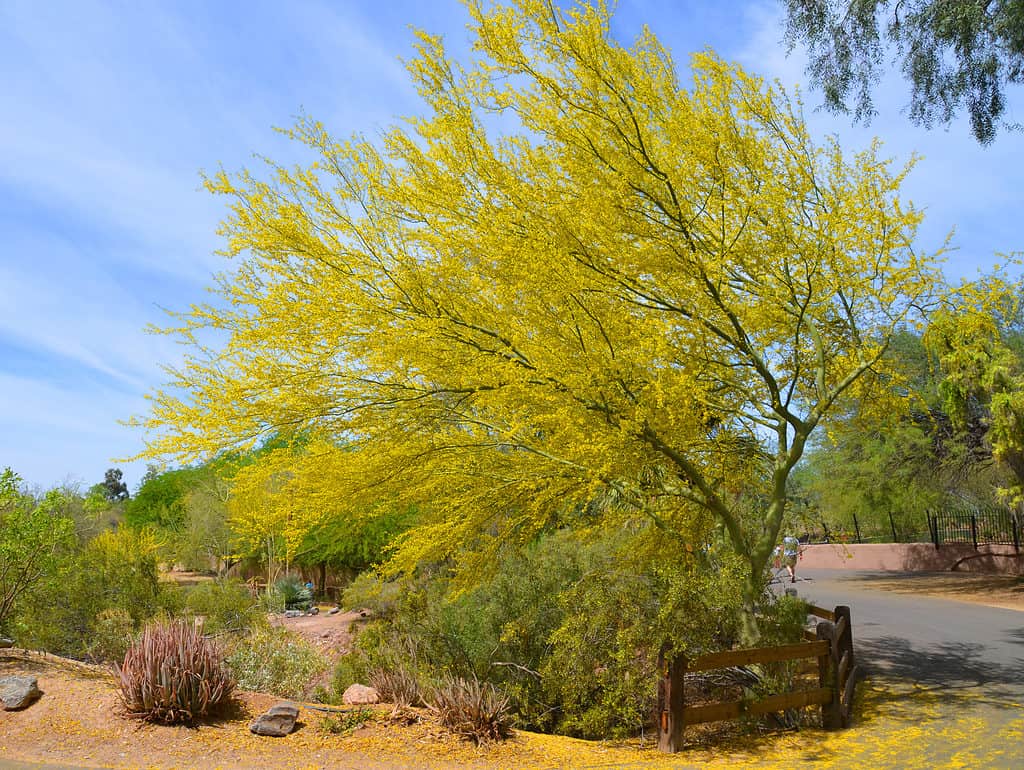
The blue palo verde bursts into color with bright yellow leaves in the spring.
©meunierd/Shutterstock.com
10. Netleaf Hackberry (Celtis reticulata)
This hardy tree can handle a variety of environments. Found at elevations from 1,500 – 6,000 feet, the netleaf hackberry can tolerate both flooding and drought. It thrives in nutrient-poor soil and scorching sun.
The green leaves of the netleaf hackberry have a texture similar to fine sandpaper. It produces small red-orange fruit in the fall, which is a favorite of local birds. If uneaten, the fruit can survive well into the winter.
The tree is a food source for a variety of Arizonan fauna. While birds are drawn to its berries, mule deer and bighorn sheep love to munch on its twigs.
It has also been a historic food source for humans. The berries and seeds have long been harvested by Native Americans who consumed the berries fresh and also ground and preserved them.

The green leaves of the netleaf hackberry have a texture similar to fine sandpaper.
©IanRedding/Shutterstock.com
Animals That Live in Native Trees in Arizona
Arizona’s native trees are not only important for their beauty and ecological benefits, but they also provide a habitat for a diverse range of wildlife.
Here are three animals that commonly live in native trees in Arizona:
- Mexican spotted owl: The Mexican spotted owl is a nocturnal bird of prey that is native to the southwestern United States and Mexico. It is listed as a threatened species under the Endangered Species Act and is known to inhabit mature forests, including Arizona’s native trees such as the Arizona white oak and ponderosa pine.
- Red-naped sapsucker: The red-naped sapsucker is a small woodpecker that is found in western North America, including Arizona. It is named for its habit of drilling small holes in tree bark to feed on the sap and insects that are attracted to it. It is often found in deciduous trees such as the Arizona sycamore and cottonwood.
- Abert’s squirrel: Abert’s squirrel is a tree-dwelling rodent that is found in the southwestern United States, including Arizona. It is named after Colonel John James Abert, who first described the species in the mid-1800s. Abert’s squirrels are often found in ponderosa pine forests, where they feed on the cones and bark of the trees.
In addition to these three animals, many other species of birds, mammals, and insects rely on native trees in Arizona for shelter, food, and nesting sites.
Summary of 10 Incredible Trees Native to Arizona
| Rank | Species | Maximum Height | Special Features |
|---|---|---|---|
| 1 | California Fan Palm | 60 feet | Numerous evergreen leaves |
| 2 | White-thorn Acacia (Acacia constricta) | 20 feet | Inch-long white thorns Puffy yellow blossoms which appear in late spring and late summer |
| 3 | Catclaw Acacia (Acacia greggii) | 25 feet | Curved sharp thorns on the stems and branches similar to the claws of a cat Yellowish-cream-colored flowers which appear in the spring |
| 4 | Desert Ironwood (Olneya tesota) | 30 feet | A unique domed leaf canopy that can extend all the way to the ground. An impressive lifespan of up to 500 years |
| 5 | Western Honey Mesquite (Prosopis glandulosa) | 30 feet tall | Yellow blossoms which appear in spring Red or purple seed pods which appear in summer |
| 6 | Smoke Tree (Psorothamnus spinosus) | 20 feet | A smoky-gray color Vibrant purple blossoms which appear in early summer |
| 7 | Soapberry (Sapindus drummondii) | 30 feet tall | Deciduous leaves which turn yellow and gold before they are shed Clusters of white blossoms which appear in spring and early summer |
| 8 | Ponderosa Pine (Pinus ponderosa) | Over 200 feet | Pine cones which have a purple tint before they are shed but turn brown once they fall to the ground |
| 9 | Blue Palo Verde (Parkinsonia florida) | 30 feet | Bright yellow foliage which appears in spring Bright yellow flowers which appear in mid-spring |
| 10 | Netleaf Hackberry (Celtis reticulata) | 35 feet | Pale green leaves with the texture of fine sandpaper Small edible red-orange fruit and seeds |
Thank you for reading! Have some feedback for us? Contact the AZ Animals editorial team.

